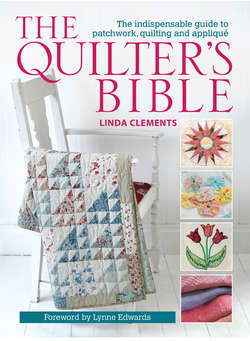Читать книгу The Quilter's Bible - Linda - Страница 14
На сайте Литреса книга снята с продажи.
ОглавлениеMaterials
This section looks at the materials you may need for patchwork, appliqué and quilting, including fabrics, threads, wadding (batting), interfacings, stabilizers, fusible web and embellishments. Obviously, a whole book could be devoted just to this subject so further reading is advised.
Fabrics
Fabrics are what draw people to patchwork, quilting and appliqué – glorious, versatile fabrics in all their many types and hues. Who is not drawn to crisp, clean cottons and linens, softly shimmering silks and satins or plush, strokeable velvets and cords? The fabrics used for patchwork and appliqué can come from many sources. Originally, they were recycled from old clothing and household linen but today are more likely to be bought new from patchwork and quilting stores and increasingly via websites. Pure 100 per cent cottons are top of the list for patchwork and quilting but there are other fabrics that can be used, particularly for appliqué and crazy patchwork. Some of the common fabric types are described below but quilt artists are increasingly stretching the boundaries on fabrics and materials that can be used.
Just as fabrics chosen for quilt tops vary, so too can backing fabrics. A quilt backing is usually chosen to coordinate or link with the front of the quilt and may be calico or a plain or printed cotton in a similar weight to the quilt top. Increasingly, though, quilt backs are being pieced to make them nearly as interesting as the front of the quilt. See Estimating Fabric Requirements and Choosing Backing Fabric for more on backings.
Fabric Themes
When buying fabric, especially when visiting websites, you will often see that it is themed. Themes reflect popular tastes and can help you select fabrics that work well together. Themes come and go but popular categories might include reproduction, patriotic, Asian, floral, animals, children, batiks, seasonal and contemporary.
Themed fabrics: (left to right) batiks, nursery and reproduction
Fabric Types
Cottons – Cotton fabric is the first choice for quilt making because it is easy to work with, does not fray too badly and drapes well. Cottons dye and print readily, resulting in plain colours, mottled, marbled and colour-on-colour effects. Cottons can be solid-dyed, tie-dyed and random-dyed, not to mention wax-dyed, the process that creates wonderful batiks. The range of printed cotton available today is overwhelming, and prints can be tiny or large, subtle or bold, monochrome or multicoloured. You can also dye and print your own fabric.
Silks and satins – These are a little more temperamental than cotton but well worth using for the wonderful sheen and glamour they create. Silk dupion is a good material to try as it irons well and comes in a good range of colours, including shot effects with two colours. Silks and satins are more prone to fraying but careful handling reduces this, as does using a wider seam allowance of 1⁄2in (1.3cm).
Sheers – There are many sheer and transparent fabrics that can be used, particularly for shadow appliqué work, including voile, organza, net, nylon, organdie, tulle, chiffon and georgette. They are usually soft and delicate but not the easiest fabrics to work with. Fraying can be a problem and they are not durable enough for normal patchwork but they can create some lovely special effects. When pressing, always use a cool iron and a press cloth on top of the sheer fabric.
Metallics – Many metallic fabrics are available today, as well as cottons shot through with metallic threads. They bring a touch of opulence to quiltmaking and a visual quality not often appreciated in a photograph. They are also fabulous for techniques such as stained-glass appliqué and crazy patchwork. The behaviour of metallics varies, depending on the synthetic content. Some are quite biddable, particularly those blended with cotton; others are very wayward, fraying badly and melting at the mere suggestion of an iron, so experiment with small pieces first.
Synthetics – Fabrics made from synthetic or man-made fibres also have a place in patchwork and appliqué, especially for creating special effects. These include Lurex fabrics, those with plastic surfaces and those mimicking silks and satins. Sequin- and diamanté-studded fabrics can also be great fun to use. As with sheers and metallics, these types of fabric need careful handling and testing.
Craft felt and wool felt – These fabrics are not useful for traditionally pieced quilts but are very popular for small projects and appliqué work. Felt does not fray because it is a bonded rather than a woven fabric. Wool felt is made from a mixture of wool and rayon. It is softer and more flexible than craft felt and is available in a wider range of colours.
Specialist fabrics – Some fabrics have been developed to create special effects, for example water-soluble fabrics, fabrics that can be printed on and shrinkable fabric for ruching. Shrinkable fabric is activated by steam and is available with different shrinkage rates, including 15 per cent and 30 per cent. Specialist fabrics can be used creatively, especially for quilt art.
